During the entirety of Apple’s WWDC 2010 keynote, we noted that many journalists were alarmed, surprised, shocked and even curious about the final hardware decisions that the company implemented into its fourth-generation iPhone. Nevertheless, Steve Jobs, co-founder and CEO, just finished giving his two-hour keynote on the Apple ecosystem this year, including the highly anticipated new mobile device that everyone and their mothers have been dying to know about.
Thankfully, Jobs was able to lay out the specifications and
features of the company’s new smartphone in a straightforward, systematic
fashion. He highlighted 9 features as being particularly important to the new
device.
Before we get into the specifics, we are going to start by giving
the device a proper name. As of the WWDC keynote on June 7, 2010 at
approximately 10:31am, the official name of the device is Apple iPhone 4. Earlier
this week, Engadget posted a poll on its site asking users what they believed
the new device would be called. Going with popular belief, the majority of
participants unilaterally assumed that it would be named iPhone HD (58,479), followed by iPhone 4G (18,809), followed by iPhone 4 (12,512). The iPhone 4 is now presented
on Apple’s front page with a rather arrogant motto: “This changes everything.
Again.” Let’s take a look underneath the hood and determine whether this fourth-generation
smartphone really changes anything, as the company so proudly insists.
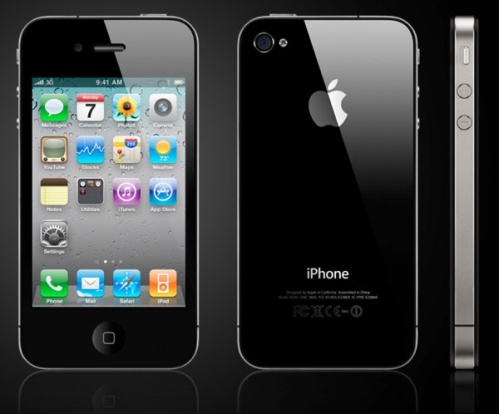
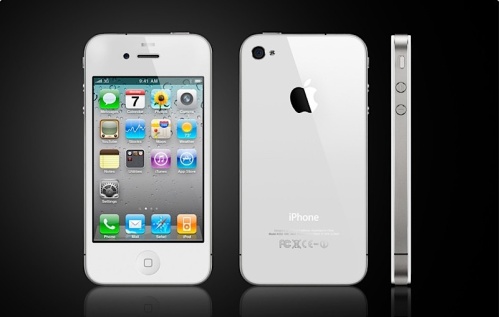
From the press shots, it is immediately noticeable that the
physical dimensions of the screen have not changed from previous iterations of
the hardware. Based on the announcement, the iPhone 4 features the same 3.5-inch
display as its predecessors, but it manages to pack four times the amount of
pixels into the same space. The phone now reps a 960x640 IPS-based LCD display
with an 800:1 contrast ratio. In comparison, the three previous iPhone models
feature mere 480x320 LCD displays. This new specification was rumored for many
months on several occasions, and we are grateful that it is part of the final
product. Steve did have a few comments to add to that spec, however. According
to contemporary research, 300ppi (pixels-per-inch) is the maximum observable threshold
that the human eye can perceive at 10 – 12 inches away from a small mobile
display. Apple officially references this vision property as the “retina
display.” Aside from the 960x640 resolution, the bigger announcement is the
fact that the iPhone 4 display features 326ppi, and Steve notes that his
company has gone “comfortably over the viewable limit” to feature the densest
display on the market.
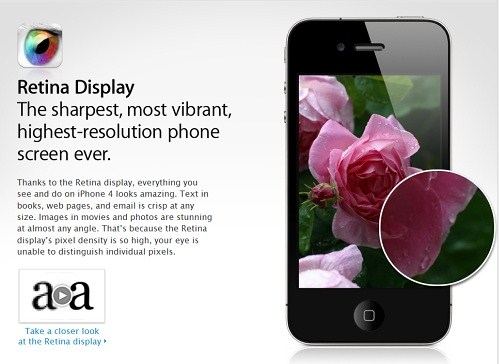
Unfortunately, we were hoping that the physical size of the
screen would rival the 4.3-inch smartphone monsters that have recently surfaced
the market, including last year’s HTC HD2 and the recent HTC EVO 4G. However,
it is important to consider Apple’s design approach marks a departure from
conventional theory that “bigger screens are always better on the eyes.” The
company has instead decided to focus its engineering efforts on ensuring that
the most pixels are squeezed into the smallest space possible, ensuring that
they go unnoticed to the user under normal operating conditions.
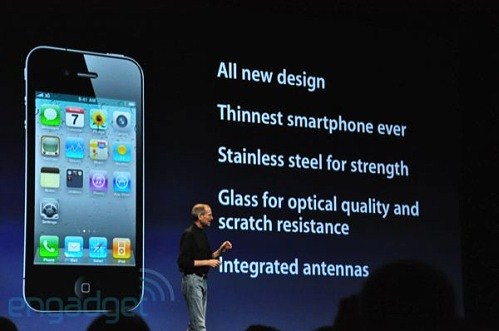
Property of Engadget
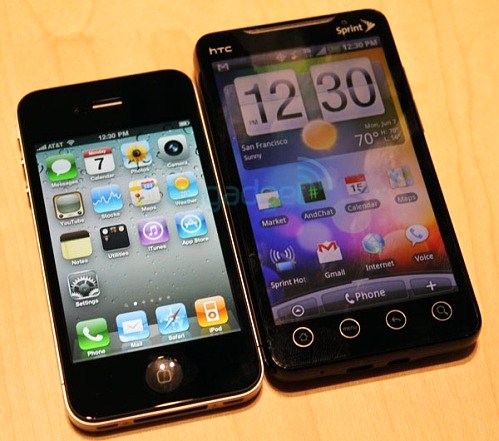
Property of Engadget
iPhone 4G positioned alongside the recently-launched HTC EVO 4G from Sprint
The iPhone 4 is also one-fourth thinner than the iPhone 3GS.
In fact, Steve Jobs claims it is “the thinnest smartphone on the planet.” Apple
was able to redesign the frame of the device to keep it at a very slim 9.3mm
thickness, roughly 24 percent thinner than the iPhone 3GS. During the
presentation, Jobs laughably insisted that the final device is "identical to the leaked prototype" that surfaced back in April. Volume controls are on the left side,
as well as a ring/silent button and are in the same positions as they were on previous models but have been slightly revised to match the device's slimmer aesthetic. The iPhone 4 also features the traditional microphone
port, 30-pin connector on the bottom, speaker, headphone jack, a second
microphone, and a sleep-wake button. The 3G micro-SIM card slot has also been repositioned from the top of the device to the right side, and it is important to note that regular SIM cards will not be able to fit into this new slot type. This has already been demonstrated on the iPad, but the interesting question that seems to have everyone concerned is whether or not AT&T subscribers with the iPhone 4 will be able to use their micro-SIM cards with the iPad, or vice-versa.
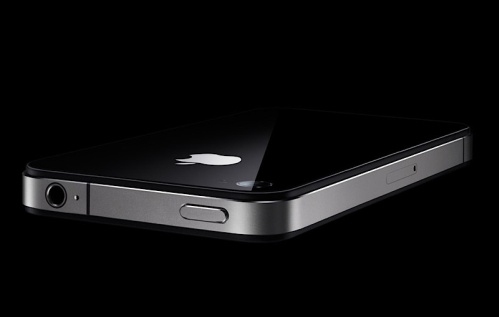
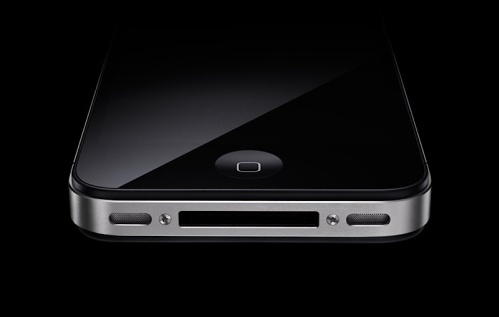
Thinnest smartphone
ever, stainless steel for strength, glass for optical quality and scratch
resistance (on front and back)
Jobs continued by noting that the iPhone 4 has a stainless
steel band that runs around the edges, a primary structural element on the
phone. “Three slits in it and its part of brilliant engineering,” he said. We
went behind the scenes after the keynote to discover why this new antenna
design was implemented. According to FCC documents that were posted literally minutes
after the keynote, the Commission identifies the fourth-generation iPhone
as a pentaband 3G phone with five bands of 3G compatibility. In other words, it
supports UMTS 1, UTMS 2, UTMS V, UTMS VI and UMTS VIII. In addition, it also
includes a Bluetooth radio, a GPS radio, and a much-appreciated 802.11n WiFi
radio.
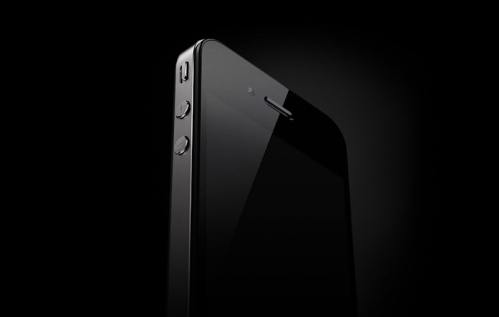
Apple’s iPhone 4 also gets a processor upgrade to the same
ARM-based 45nm Apple
A4 1GHz chip used in the iPad, an upgrade from the 65nm ARM Cortex A8 600MHz
in the iPhone 3GS that Anand Shimpi gave a detailed architecture analysis. Nowhere
in the keynote presentation was there mention of how much RAM that iPhone 4
contains, but DigiTimes recently stated that it features a 512MB
memory module from Samsung. If this claim is true, then the RAM capacity is
also an upgrade from the 256MB found in the iPhone 3GS.
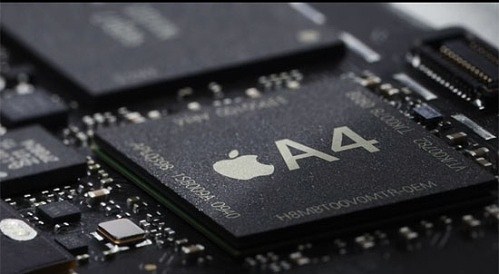
The new iPhone 4 hardware also incorporates a new 3-axis
gyroscope in addition to the accelerometer. The combination of these two sensors
will ultimately provide 6-axis motion sensing (see: PlayStation 3 SIXAXIS Wireless
Controller). With six degrees of rotation in a compact physical space,
Apple hopes that its developers will design even more immersive gaming
experiences that enable gamers to have full control over their virtual
environments.
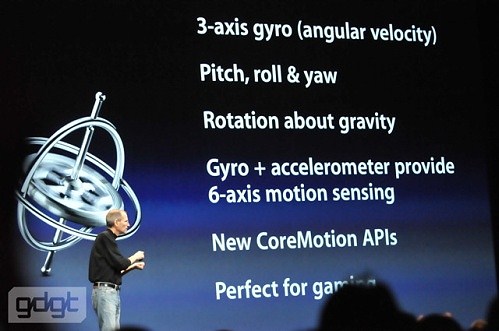
Property of gdgt
One of the more anticipated features of the new device is
undoubtedly the camera improvements that have been rumored for so long. Apple
has finally put its loyalist customers at ease by announcing that iPhone 4 features
a “whole new camera system.” It’s got a 5 megapixel CMOS sensor on the back and
an integrated LED flash positioned right next to it for low-light photography
and video recording (yes, the LED works for video recording as well). “We went
from 3MP to 5MP and kept the pixels the same size,” Steve said during his
demonstration. He also mentioned that the new camera system supports
geolocation embedding for both photos and videos. In addition, the new phone features
5x digital zoom built into the new iOS 4 camera application with tap-to-focus. All
in all, the new camera system will be able to record full 720p (1280x720) HD
video at 30fps just like the HTC Incredible and HTC EVO 4G.
Randy Ubillos, Apple Chief Architect of Video Apps later
went on stage to demonstrate iMovie for the iPhone. It’s a full-featured video
editing app environment for the phone, where photos and videos can be added to
a project timeline and special effects can be added with the tap of a finger.
Photos automatically get the “Ken Burns effect,” and the most interesting
feature is that the camera records geolocation information into the video,
which then gets automatically picked up by iMovie and put into the screen. The
app will be available in the App Store for $4.99.
Steve Jobs continued his keynote by presenting the new iAd
mobile advertising platform, which we’ve covered here. At the end, he famously
introduced his “One More Thing,” which happened to be a full-fledged video
calling application exclusively for the new iPhone 4. The application will make
use of the new device’s front-facing camera, currently without any announced
specifications, but will unfortunately only be available over WiFi throughout
the rest of 2010. Jobs has stated that the company is “in talks with network
carriers (AT&T) to support it over 3G.” More on that here.
Of all the hardware innovations that were carefully introduced into the iPhone 4, one of the biggest improvements that we are most thankful for is the gigantic Lithium-Ion battery that Apple has planted into the back of this new smartphone. Steve Jobs himself claims that it will be capable of supporting 10 hours of video playback, 40 hours of music playback, 6 hours of 3G Internet browsing, 10 hours of WiFi Internet browsing, and 40 percent more talk time on 3G to 7 hours (up from 5 hours). In addition, this new battery is arsenic-free, BFR-free, mercury-free, PVC-free and highly recyclable.
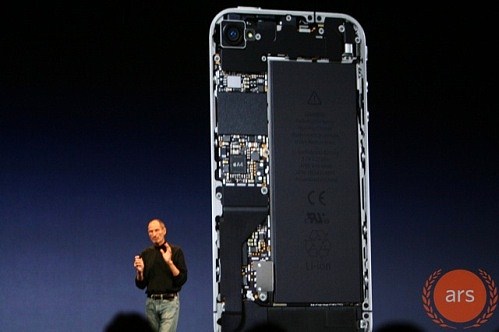
Property of ArsTechnica
There are many aspects of the iPhone 4 hardware and software
feature set that we are both content with and moderately disappointed with.
Aside from our discontent with FaceTime’s WiFi-only usability, we were also
frustrated about the storage capacity options for the new phone models. After
Steve had announced that the iPhone 4 would be available in both black and
white colors, he also mentioned that they would only be available in 16GB and
32GB capacities just like the iPhone 3GS. Over the past twelve months, many
iPhone 3GS 32GB users around the world, including ourselves, have accumulated a
significant storage buildup on our smartphones with little space for
application and media expansion. We were hoping that Apple would announce 32GB
and 64GB capacities for its fourth-gen hardware iteration, but unfortunately it
probably decided to use the same Toshiba NAND-flash memory chips it has been
using for the past year in order to save costs associated with newer features
of the phone. We will have more information behind the company’s decision as
soon as the Bill of Materials list gets published in a few weeks.

Property of Engadget
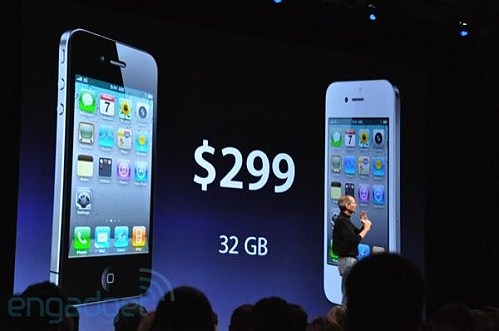
Property of Engadget
Apple did manage to keep the same pricing structure for its
new phones. The iPhone 4 16GB (black and white models) will release for $199,
while the iPhone 4 32GB models will release at $299.
Early on, Jobs did point out that his favorite statistic of
the entire keynote was the fact that 70 percent of revenue from the App Store
goes to the developer. Currently, the company just crossed the $1 billion
milestone for developer revenue. “That’s what makes the App Store the most
vibrant community on the planet,” he says. According to Nielsen research,
iPhone’s market share was three times that of Android as of Q1 2010. In total, the iPhone has 58.2 percent of the
entire mobile browser usage in the country, over two and a half times as much
as Android, at 22.7 percent.
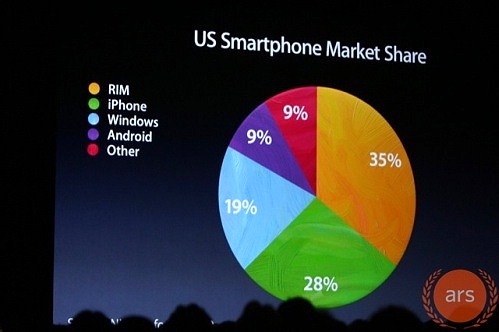
Property of ArsTechnica
Full iPhone 4 hardware specifications can be found on Apple’s
product page here. “Thank
you very much,” said Steve. "This is our new baby. I hope you love it as much as
we do.”
The release date for the Apple iPhone 4 is Thursday, June 24, 2010,
and pre-orders start on Monday, June 21.

